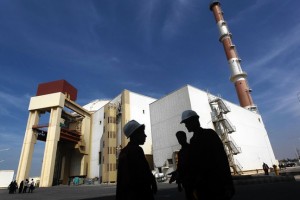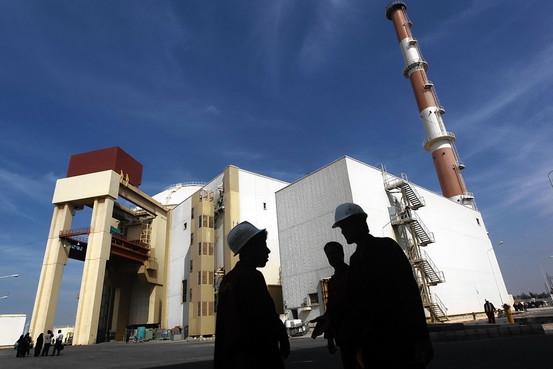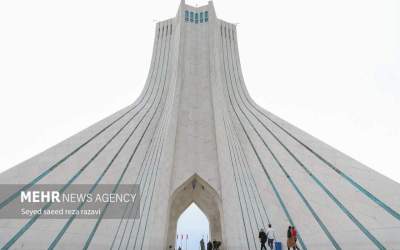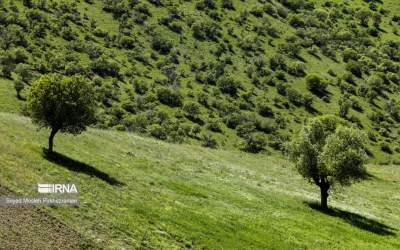 WASHINGTON�The U.S. has significantly stepped up spying operations on Iran's Bushehr nuclear reactor over the past two months, American officials said, driven by heightened concerns about the security of weapons-grade plutonium after Tehran unexpectedly discharged fuel rods from the facility in October.
WASHINGTON�The U.S. has significantly stepped up spying operations on Iran's Bushehr nuclear reactor over the past two months, American officials said, driven by heightened concerns about the security of weapons-grade plutonium after Tehran unexpectedly discharged fuel rods from the facility in October.The increased U.S. surveillance of Bushehr, on Iran's southwestern coast, has been conducted in part with the Pentagon's fleet of drones operating over the Persian Gulf. The effort resulted in the interception of visual images and audio communications coming from the reactor complex, these officials said.
Tehran suggested an American drone was spying on Bushehr on Nov. 1 when it sent Iranian fighter jets to pursue the unmanned craft, firing at it but missing. The drone in question was conducting surveillance that day, but not on Bushehr, U.S. officials said.
U.S. officials stepped up surveillance after becoming alarmed over activities at Bushehr, especially the removal of fuel rods from the plant in October, just two months after it became fully operational, officials said. Nuclear experts said they are more concerned about safety at the reactor, for now, than about the prospect that Tehran will use the facility to develop atomic weapons.
Tehran formally protested the Pentagon's spying activities in a Nov. 19 letter to United Nations Secretary-General Ban Ki-moon, according to a copy seen by The Wall Street Journal. The complaint charged that the U.S. has repeatedly violated Iranian airspace with its drone flights. But U.S. officials maintain that surveillance is conducted off the country's shoreline, in line with international law.
The extent of the U.S. surveillance activity underscores the limits of U.S. knowledge about Iran and its military and scientific bureaucracy, and points to anxious efforts by Washington to increase its understanding as an international confrontation looms over Tehran's nuclear program.
Officials wouldn't detail the type of surveillance under way at Bushehr, but drones are known to be capable of intercepting cellphone calls, electronic communications and other signals.
Eavesdropping on Iranian communications could provide clues to what the country's nuclear engineers were doing when they began moving fuel rods out of the Bushehr plant in October.
The U.S. normally views the 1,000-megawatt Bushehr reactor as a lesser proliferation and security threat than Iran's growing number of uranium-enrichment facilities. Both the reactor and the enrichment plants produce fissile materials that can be used to develop nuclear weapons. But Russia's State Atomic Power Corp., or Rusatom, built and commissioned Bushehr under an agreement that all spent fuel would be returned to Russia and stored.
So the International Atomic Energy Agency was surprised on Oct. 15 when Iran notified the U.N. watchdog that it was discharging all of the nuclear fuel from Bushehr and storing it in a cooling pond at the site, according to Vienna-based diplomats briefed on the correspondence.
Independent nuclear experts estimate that this discharged fuel was made up of between 22 and 220 pounds of weapons-grade plutonium, enough to produce as many as 24 nuclear bombs, if reprocessed further.
Nuclear fuel in power reactors is discharged and replaced as part of normal operations, these experts said. But Tehran took the action roughly two months after Rusatom said the Bushehr facility became fully operational, rather than the usual time frame of 12 to 18 months.
Also, Iranian government officials have said in recent weeks that local engineers wanted to oversee the fuel discharge as part of plans for Rusatom to transfer operational control over Bushehr to Tehran in coming months.
The discharge was part of a "normal technical procedure" associated with Iranian engineers taking control of Bushehr, Iran's ambassador to the IAEA, Ali Ashgar Soltanieh, told reporters in Vienna in November.
The IAEA wrote about the fuel transfer at Bushehr in its November quarterly report on Iran's nuclear program, but it didn't state the reason for it.
The report said Tehran was shifting the spent fuel rods to the cooling pond from Oct. 22-29, dates that roughly corresponded to when Iran said U.S. aircraft were conducting heightened reconnaissance missions near Bushehr. The IAEA said its inspectors confirmed the rods were in the cooling pond during a visit to the site on Nov. 6-7.
U.S. officials said the mystery at Bushehr alarmed the Obama administration, which is normally focused on Iran's activities at its two main uranium-enrichment facilities in the cities of Natanz and Qom.
Administration officials and independent nuclear experts said they doubted Iran was attempting to extract the weapons-grade plutonium from the fuel rods. The IAEA doesn't believe Iran currently has a reprocessing facility to separate plutonium from Bushehr's spent fuel.
The IAEA also has cameras and seals at the Bushehr facility to detect and guard against any diversion for military purposes, as well as regular visits by inspectors.
Still, the fuel transfer has raised concerns in Washington about Bushehr's operational safety. Experts said Iranian engineers could potentially try to extract plutonium from Bushehr in a crisis or military confrontation with the West, once they master technical procedures.
"The proliferation threat at Bushehr doesn't seem imminent. But it raises questions about what could happen if there's a conflict," said David Albright, who heads the Institute for Science and International Security, a Washington think tank.
A spokesman for Rusatom in Moscow on Friday said the fuel discharge was a planned removal for safety testing. He denied a Reuters report that the shutdown was because of safety concerns after stray bolts were allegedly found under fuel cells at the plant.
Iranian state media reported last week that Iranian engineers have returned the fuel rods to the Bushehr reactor's core from the cooling pond.
In their complaint to the U.N., Iranian officials said American drones have repeatedly entered the country's airspace, prompting the Nov. 1 military action against the U.S. craft.
"Recent operations carried out by United States planes violating the airspace of the Islamic Republic of Iran include flights that took place over the coastal areas of Bushehr on 7, 13, 15, 20, 22, 23, and 26 October 2012, endangering the safety of air navigation," Iran's ambassador to the U.N., Mohammad Khazaee, wrote.
He said the U.S. "disregarded all radio warnings" before Iran shot an airborne cannon at the drone.
U.S. officials briefed on Pentagon reconnaissance denied any drone violated Iranian airspace. Washington has also increased monitoring of Iranian naval operations in the Gulf in recent months, following Tehran's threats to choke off oil traffic in the waterway in retaliation for widening Western sanctions, these officials said.
The concern over Bushehr comes as the U.S. and European Union this month seek to resume negotiations with Iran aimed at curbing Tehran's nuclear work.
Last week, the Obama administration gave Iran a March deadline to seriously engage with the IAEA in addressing concerns Tehran has secretly been developing nuclear weapons or risk facing a new U.N. Security Council censure. The U.N. has initiated four rounds of economic sanctions on Iran in recent years, and U.S. officials said they could move to enact a fifth.
"Iran cannot be allowed to indefinitely ignore its obligations�Iran must act now, in substance,'' Washington's No. 2 diplomat at the IAEA, Robert Wood, told the agency's board.
Israeli Prime Minister Benjamin Netanyahu has said the international community must be prepared to take military action against Iran's nuclear facilities by next summer to guard against Tehran acquiring a nuclear-weapons capability. That is when Iran is expected to have amassed enough medium-enriched uranium to quickly convert it into weapons-grade fuel.
Iran denies its pursuing nuclear weapons. But Mr. Soltanieh, Tehran's ambassador to the IAEA, said on Friday that his country would consider pulling out of the U.N. treaty banning the development of atomic bombs if the West attacked.
By The Wall Street Journal
The Iran Project is not responsible for the content of quoted articles.











